Best Time to Visit Dolpo
April and May are the spring times in Dolpo. Though March is also considered the spring season in Nepal, March does not favour the Dolpo region, as little precipitation with strong wind flows during this time.
April and May are the spring times in Dolpo. Though March is also considered the spring season in Nepal, March does not favour the Dolpo region, as little precipitation with strong wind flows during this time.
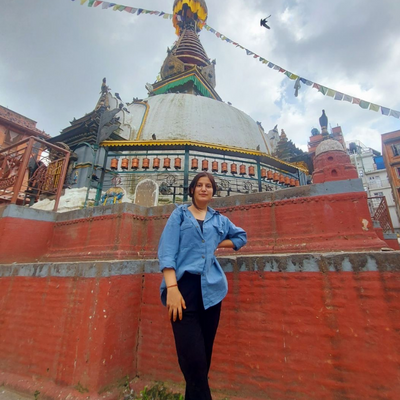
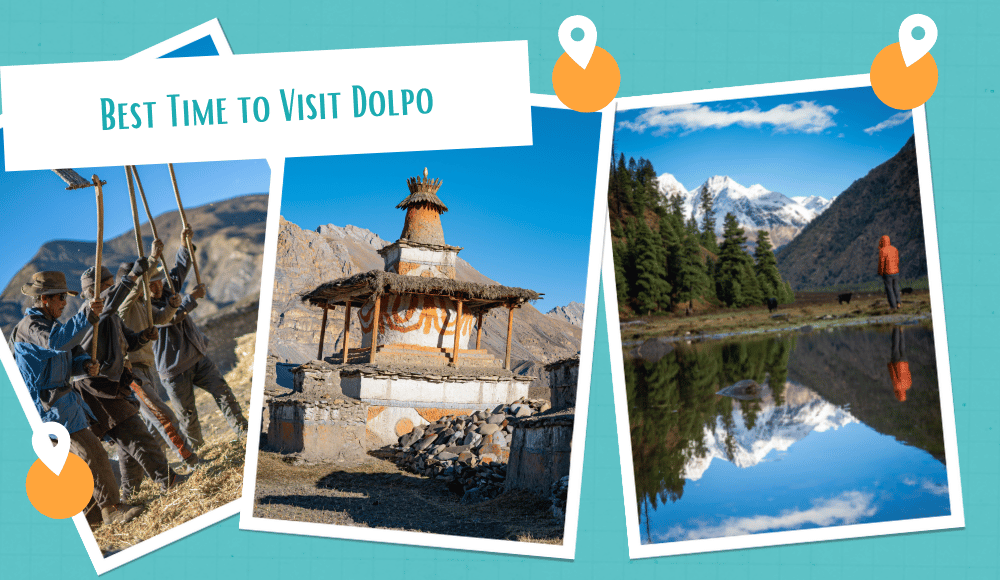
Ever wondered how it feels to live a life dominated by nature completely? Yeah, you probably had created some fictional scenarios in your Lil's head. To your amusement, Nepal offers such a fantasy, too, in the form of an isolated arid mountain settlement, the Dolpo region. Dolpo, the jewel of western Nepal, is a concealed paradise in the highlands of Nepal.
The best time to visit this mystical Dolpo varies by its two regions, the lower Dolpo and the upper Dolpo. For the Lower Dolpo, the best time to visit is June, July, August, September and October, whereas, for the exquisite Upper Dolpo, the best time to visit is the post spring and early autumn, which is Mid of April to May and September to October.
The Dolpo region is a rain shadow region conquered by the Dhaulagiri and Kanjirowa mountain ranges. Because of this, it can be visited during the summer season too, but because of the weather around other regions of the country during this time, it is tough to get to the Dolpo first, making it quite unfavourable for the Dolpo visit. If you, by any means, get to the Dolpo during this time, it will be easy exploring it, as getting to Dolpo is the biggest deal around this time, not scouring through it.
Coming to the winter season, you can’t even imagine exploring Dolpa in the harsh winter months. The temperature here decreases below freezing with heavy snowfall and strong winds. Even getting to the lower Dolpo is a big accomplishment during these months, as very few dare this as there are the highest odds of getting lost and hunted by the avalanches during this period.
So, what draws the conclusion for the Dolpo trek and visit is only a few, more significantly, April, May, September, and October are the practical months for its visit. A visit during this time allows you to immerse into the surreal nature and sheer beauty of the Dolpo region, along with the unique inhabitants and their practices. Getting through all the web searches, surfing and fiddling to get here, I Suppose you are going for or planning a Dolpo visit. In that case, this piece of work may come handy to you with all the details of the weather and environmental conditions of the Dolpo region and the possible seasonal visit to this region. Feel free to go through this, and clear up all your perplexity!
|
Country |
Nepal |
|
Region |
Dolpo, Western region of Nepal |
|
District |
Dolpo |
|
Province |
Karnali |
|
National park |
Shey Phoksundo national park |
|
Adventure type |
Trekking |
|
Difficulty level |
Strenuous |
|
Best time to visit |
September, October, April, and May |
|
Major ethnic groups |
Chettri, and Magar |
|
Major Attractions |
|
|
Accommodations |
Local Tea Houses and Camping |
|
Permit required |
|
|
Allowed to visit from |
1992 AD |
Get in touch with our experts right away and finalize an experience!
About UsDolpa, the largest district of Nepal, lies in the mid-western region of Nepal, in the province of Karnali. Dunai, being the district headquarter, this district is the most isolated district of Nepal, far beyond the health, transportation, education and network services. This district is still deprived of excellent food and decent roofs to stay under.
The territory of this district is bordered by the Tibetan autonomous region of China in the north, Myagdi, Jajarkot, and Rukum in the south, imposing Mustang in the east and Jumla and Mugu in the west. Most of the territory of this district lies within the Shey Phoksundo national park and is dominated by the Kanjirowa and Dhaulagiri mountain ranges.
Shey Phoksundo national park is the only trans-Himalaya national park of Nepal distributed over the district of Dolpa and Mugu. It houses the deepest lake at such an altitude all over the world, lake Phoksundo. The name of the national park goes after it. Not only lake Phoksundo is also the habitat of several flora and fauna, which includes the highly valued medicinal herb Yarsagumba, Panchaule, and various exotic species, Himalayan Tahr, Blue sheep, Snow Leopard, Blackbuck, yellow-throated Marten, diverse ranges of butterflies.
The best time to visit Dolpo is April, May, September and October. This time is favourable for both the lower and upper Dolpo circuit trek. If you want to take a trek around the lower Dolpo region, you could join in the spring and Autumn seasons, as this time is favourable for any region visit. Often confused this time as the ideal Dolpo visit, upper Dolpo defies this practice and forms a unique time visit of its own which is late Spring to Early autumn.
The weather is pretty decent in the months of April and May, as the precipitation is significantly less during this time. The temperature is warm, not so hot, nor so cold, making it incredibly more accessible for the trekkers. Also, the lower dense Rhododendron forests bloom vigorously in this period, charming the overall environment. This enchants the visitor into its ambience.
Talking about the most cheerful time, September and October, this time is the allrounder for every trek and tour in Nepal, and so does the Dolpo trek. Primarily, Visibility supports the best during this period as you can see the straddling peaks shining with all the glam it got. The natural mountain ambience is phenomenal during this period, radiating all the positivity in the placid cool remote zone, making it the ideal time for a Dolpo visit.
The winter time in Nepal falls in the months of December, January and February, and this is the same for the Dolpo too. The winter period in Nepal is something you may not want to miss. The environment during this time is just spectacular. The days got shorter, the nights were chilly, and the orange shade sunset was just wow. The early birds flock soaring for their shelter, and the rush of officials to get back home before the clock hits six makes the surroundings more cheerful and vivid.
Contrary to the cheerful winter, The winter in Dolpo is severe, with heavy snowfall and a freezing environment. Here the winter starts in November and ends in February. Winter in Dolpo is tough even for the locals, so for the outsider, this will be a complete nightmare with the unbearable wrath of the weather. During this time, locals at the higher elevation shift to the lower one because of the severe cold. So, trekking to these regions at such a time is a very dumb decision you could ever make.
Not just is the cold the only problem here, but also the trails during this time are. The trails get invisible with all the snow and flurries. As the valleys in the Dolpo region are well hidden even during standard time, finding them in the harsh winter months is like trying to find sugar in a heap of salt, which means very hard to find. Because of this, there is a high chance of getting lost in the middle of nowhere, so the trekkers and the visitors skip this time for the Dolpo visit.
Spring season in Nepal is the most vibrant and colourful time of the year, which falls in the months of March, April and May. Every adventure activity in Nepal is prepared for this time, and this time offers the best it has, including the bright sunny days and the upbeat surroundings.
Dolpo makes itself unique in every aspect, whether nature and the glory or its own time of visit. While visiting Dolpo, you need to wander your eye around the Dolpo Map, as you can see, it is categorised into two units, the lower Dolpo and upper Dolpo. For the lower Dolpo trek, you can choose anytime between March to May, but for the Upper Dolpo trek, you need to be more precise. Only the spring months of mid-April to May favours the upper Dolpo region, and you need to trek around this time to steal Dolpo’s deal.
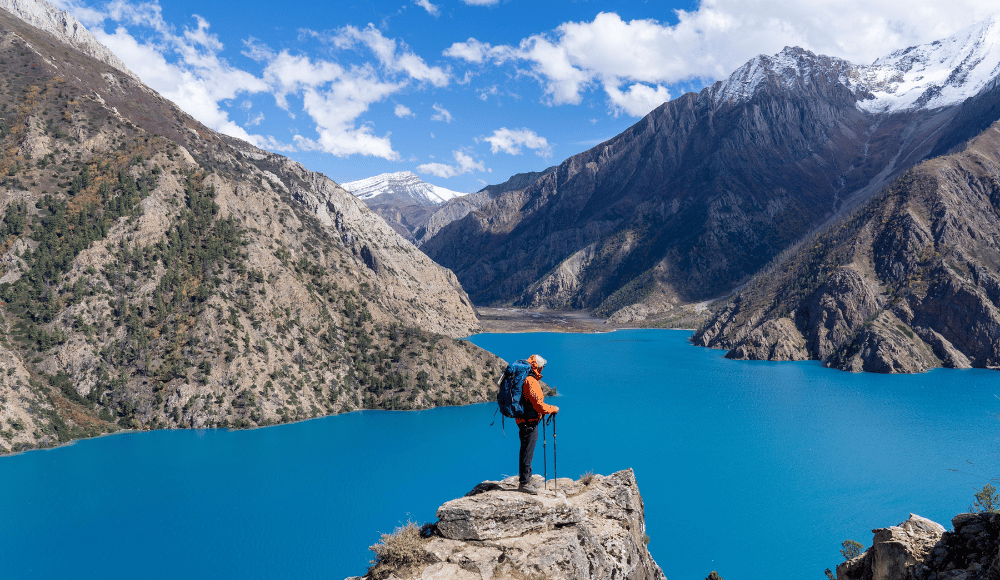
Regarding beauty, upper Dolpo dominates lower Dolpo, as upper Dolpo is the land of mud, meaning there are numerous valleys, gorges, canvases, and mountains in relatively closer proximity. So, while you trek to the Dolpo region, go for the time which favoured the upper Dolpo, not only the lower one. So, for this, nothing can beat the April and May months.
During this time, the lower region of Dolpo blushes with the blooming Rhododendron forests. Shey Phoksundo looks ethereal, surrounded by bright red Rhododendrons. Aiding the beauty will be the local's participation in their daily work and lifestyles. Coming to the upper one, the environment is remarkable, as it just lures visitors into itself. All the mountains are bright with less snow, the water flow decreases in some ranges, and all the beauty of the Dolpo region flares at this time. So, it can be concluded that if you visit Dolpo at this time, you will get the best out of the best.
Though temperature favours the spring, nature's favourite will always be the autumn. And this autumn in Nepal falls under the months of September, October and November. This is practically the best time for the Nepal visit as you will get nature in its best form. The trees change their shade into orange and red with the little early morning dewdrops in the tree branches. Also, as it is festival time in Nepal, you can find the perplexing hustle and bustle of the locals on the narrow alleys and the streets of Nepal.
Autumn in Dolpo is somehow similar to the other regions of Nepal. The only difference here is after October, the cold gradually rises in this region, making November not the ideal time even though it belongs to the vivacious and bright Autumn. Just like the other regions boast their most fantastic festival during this month, Dolpo also boasts its unique festival this month. Every 12 years in the month of September in the year of Dragon, according to the Chinese lunar calendar, a grand festival is arranged in the Dolpo region, known as the Shey festival. This festival is the most fantastic festival of all time for Dolpo residents. If you pay a Dolpo visit during September, you could collect some glimpses of their festive vibes and their unique way of celebrating it.
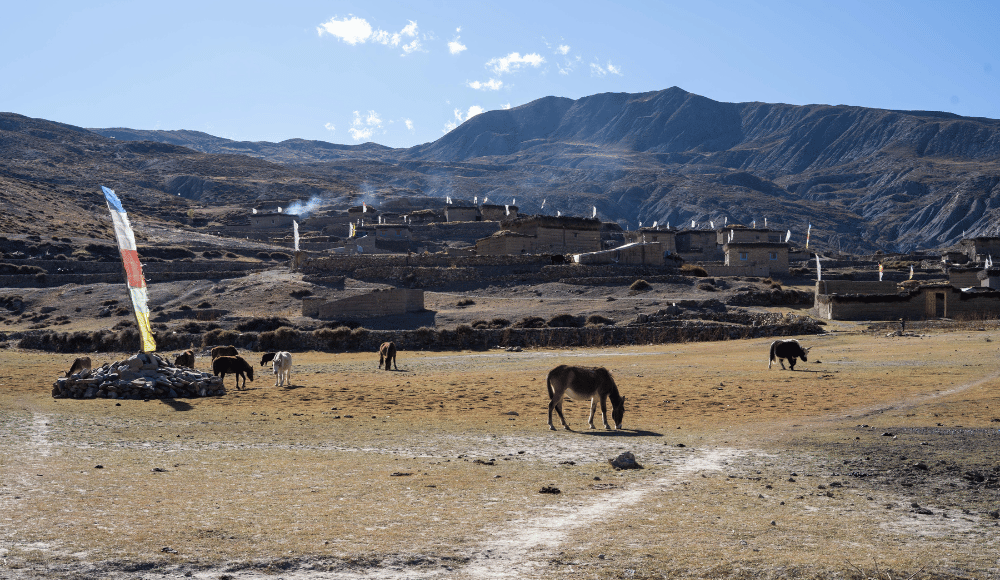
October in Dolpo is another charisma of wonderful nature. During this month, the morning starts to get a little chilly and foggy. This makes the trek in Dolpo even more intriguing. Waking up early beside the mountains in the scenic Dolpo is an experience you can't even put into words. It's more than perfect. All the temperatures, weather, and visibility are in perfect harmony during this time, proving the visit worthy in every aspect and making the Dolpo a pure utopia in the western highlands of Nepal.
As already discussed, November in Dolpo is not appropriate to visit. The weather changes around this time of year, from the vibrant, cheery autumn to the cold, gloomy winter. The upper altitude of the Dolpo will experience snowfall, and the peak will be veiled with snow. The thick black lurking clouds surround the mountains most of the time, and the view will be blocked, offering you just the numbing cold and worthless struggle.
Summer season in Nepal is taken as an off time for the treks and tours though some favours this season too. The sceptical summer falls under the months of June, July and August. Most parts of the country experience heavy rainfall at this time resulting in landslides and floods, making it inappropriate to pay a visit.
Summer doesn't influence Dolpo in a vast range as it is a rain shadow region of Nepal, towered by the Dhaulagiri mountain range. So, visiting Dolpo in the summer can be a wise choice, but before visiting Dolpo, you need to reach Dolpa first, which can be a big deal here. Since heavy rainfalls take place in several parts of the country, Dolpa becomes nearly inaccessible during this time.
Because of the continuous rainfall, maximum flights are cancelled during this time. One has to wait more than 4 to 5 days to take a single flight to Nepalgunj, and the next flight to Juphal is the literal dream which means it's doubtful to get a flight to Juphal within 2 to 3 days in this season. It may even take a week to get to Juphal by flight as very few flights take off during this time.
After getting to Dolpo, you can take your time and explore this region well, as you will not be disturbed by the rainfall and all. All the geographical features and attributes of the Dolpo region are equally visible during this time, so during the summer season, getting to Dolpo is a tough deal, while visiting Dolpo is a piece of cake.
You can reach Dolpo in three ways: By flight, By helicopter, and By driving. A brief description of these is cited below:
To get to Dolpo from Kathmandu, you must take a flight to Nepalgunj first. From Tribhuvan international airport, you will board a flight to Nepalgunj. It may take around 45 minutes to get to Nepalgunj from Kathmandu. After arriving at Nepalgunj, you will rest there for the night as only morning flights are operated for the Juphal. The next day in the early mornings, you will head to Juphal, which may take around 30 minutes. After Juphal, you'll start your trek to Dolpo, which goes via Dunai. This is the most straightforward and most followed pattern to reach Dolpo. Except for some flight issues, delays and cancellations, this is the best way to reach Dolpo.
This is the best possible alternative for those who wish to visit Dolpo in a short time. For this, you will take a flight to Nepalgunj from TIA, Kathmandu. As discussed above, you will rest for the day in Nepalgunj since no flights are boarded for Juphal in the late afternoon and evenings. Next morning you will take a helicopter ride to Juphal, which may take around an hour. Also, there is a weight limit for this helicopter option, which varies by the capacity of the helicopter. This allows you to have the best aerial view of the Dolpo region, which indeed includes the numerous waterfalls and the Kanjiroba Himal range. After getting to Juphal, there are two options available to you, either you will trek onwards or again fly to the Upper Dolpo. Either way, you will land at Juphal once for refuelling and all. This is best suited for those who want to explore Upper Dolpo in less time and want to escape the strenuous trekking.
To get to Dolpo from Kathmandu, you must take a bus to Nepalgunj first. It may take around 18 hours to reach Nepalgunj from Kathmandu. So, for the first day, you will have to rest at Nepalgunj. The next day you will drive to Jajarkot and then take a private vehicle, a jeep, to Sulighad. Sulighad is the Shey Phoksundo national park’s headquarters which marks your arrival at Dolpo. Then you will trek above to explore the mystical Dolpo. Though the drive to Dolpo is available, it is still skipped by trekkers a lot. It's because the road leading to it is not in the best condition and you have to spend extra time in various places. Also, Frequent landslides hover around these trails and the trail after Nepalgunj is not that easy either, extremely rocky and bumpy with several turns.
Not only these three, but there are also several routes taking you to the Dolpo. You can join that trail, too, to get to Upper Dolpo. One widely used is the Upper Dolpo trek from Mustang. This takes you through the beautiful Jomsom, Kagbeni, to the enchanting Dolpo.
Dolpo is full of nature, so getting its implausible beauty in words seems impossible. Still, I merely attempted to portray its beauty in words mentioned below. You can go through that for further reference.
Shey Phoksundo national park is the largest national park of Nepal, occupying an area of 3555 sq km distributed over the district of Mugu and Dolpa. It houses the deepest lake at this altitude, lake Phoksundo. The turquoise blue lake steals all the limelight of this national park as it looks heavenly. Near this lake’s outlet, there is the country's highest waterfall. Apart from this lake and waterfall, this national park is the habitat of several flora and fauna, which includes the endangered Snow leopard, and musk Deer. Also, several ethnobotanical importance herbs are found in this National Park. Some of them are Yarshagumba, Jatamasi and Panchaule. In addition, 29 species of butterflies colour this national park with their multicolor wings. Aiding the beauty of the national park are the typical Tibetan villages and their distinct cultures.
The turquoise blue Phoksundo lake is the deepest lake at 3611m. It is an oligotrophic freshwater lake distributed over 494 ha of land. This lake is considered sacred among the locals. It is believed that a new underwater world lies inside the lake, and the locals worship them as a deity. Not only through religious beliefs, but This lake also looks magnificent with its aquamarine shade along the reflection of the mighty Kanjirowa. Near the lake shore in the northern region, there is the typical Ringmo village which is another wonder to observe. This lake area is surrounded by dense coniferous, which includes blue pine, Himalayan birch and rhododendron bushes. The peace, tranquil surroundings, and divine lake make this place a piece of heaven. It can be said that this lake is responsible for getting the Dolpo among the crowd, as every year, this lake receives hundreds of trekkers.
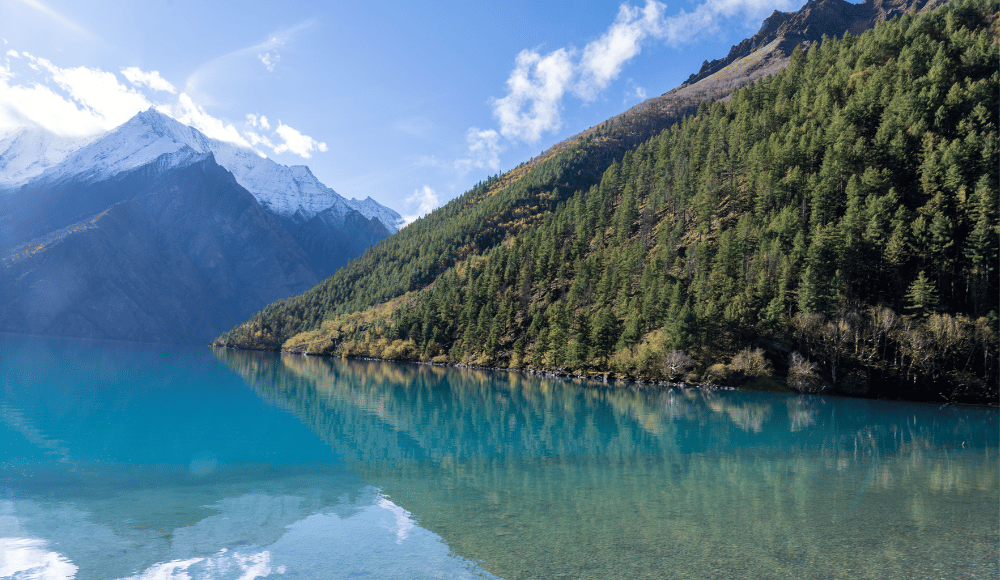
Shey Gompa is the oldest gompa in this region, constructed in the 11th century. This Gompa is the pillar of the spiritual beliefs of the locals in this area. Lying at an elevation of 4100m, right at the base of Crystal Mountain, this Gompa is a two-storey building painted in two colours, red and white. The Gompa’s inside wall is crafted with Buddhist mantras. The name “Shey” suggests the biggest among all, hence appreciated by many. Every 12 years, in the courtyard of this Gompa a huge festival is arranged known as Shey Festival. Buddhists from all over the world flock here during this festival as this festival is a symbol of their victory over evil in ancient times. Also, one fascinating fact about this festival is, during this festival the Buddhist pioneers make a rotation around Crystal mountain, which is considered the brother of Mount Kailash.
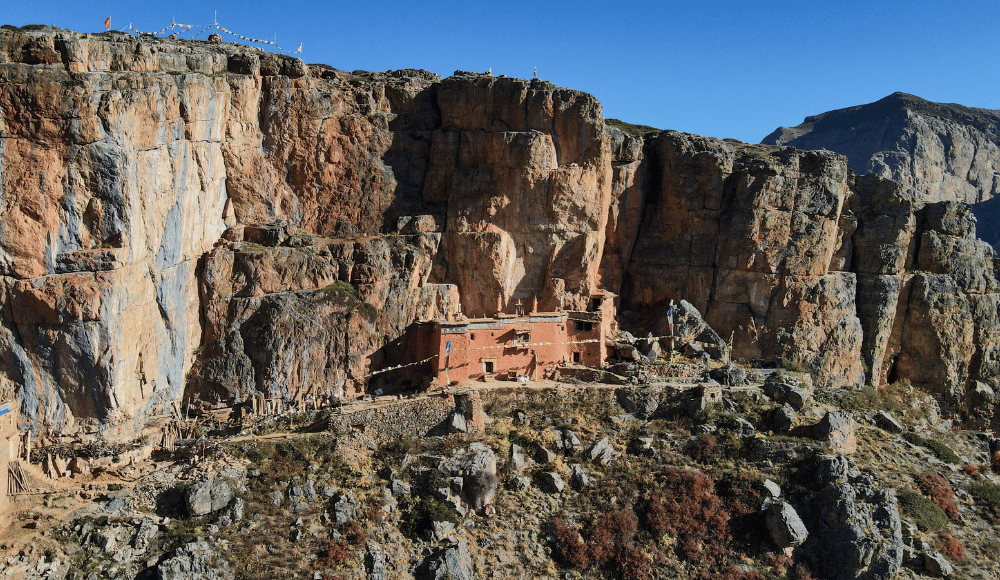
Related read: 10 popular himalayan festivals in Nepal
Dolpo, a rural district of western Nepal, is a hidden gem prevented from evil modernisation. This District boasts several muddy valleys and hill-edged settlements. One of the majors is the Dho village, the highest human settlement. Not only Dho, but there are also several villages such as Ringmo, Tilje, Shey, and many more. To get to another village from one village, you have to cross a high pass, which makes the villages and the settlements more unique. Also, these villages are well hidden by the hills, gorges and barrens. You can observe the locals' participation in every activity in the village, from building a small bridge in the river to constructing the road for access. A perfect example of unity in diversity is observed here. Therefore, the small hamlets lined by stone walls, innocent smiley locals, slanted fields with small water canals, barren hills, and the straddling peaks make these settlements a happy place within nature away from urban life.
One exclusive feature of the Dolpo, specifically Upper Dolpo are the vastly scattered monasteries, Chortens and Gompas. You can see multiple Chortens and Gompas in every trail of the Dolpo region. Shey Gompa and Tshowa monastery are the major ones. Locals are seen hovering above these regions every single day. Mainly this region is influenced by Tibetan Buddhism and The ancient BonPo religion.
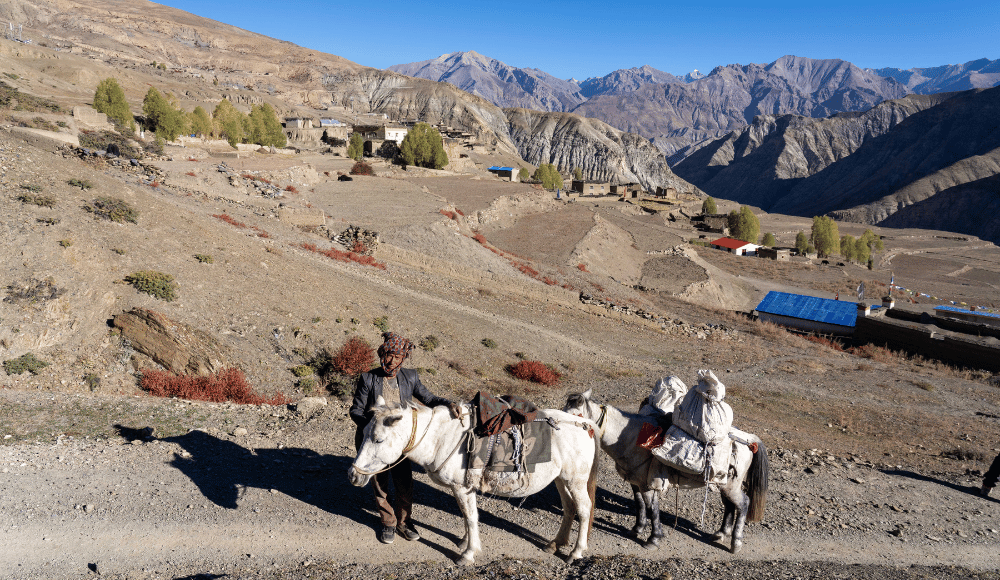
Ringmo village is where you can find raw, unspoilt and unfiltered ancient Tibetan Buddhism. The practices locals perform here are unique, which is fascinating. Apart from Buddhist culture, another prominent feature here is the ancient Bonpo religion. This Bonpo religion is the base foundation of Tibetan Buddhism, so this differs slightly from Buddhism. One significant difference is the anticlockwise rotation around the holy sites. Because of this mixed religion and tradition, it's common to have several religious shrines in abundance.
Related read: Buddhist monasteries in Nepal
Dolpo is a region in Nepal, where life revolves around the yaks, mules, and sheep. The lifestyle here totally lies below the poverty line. Though nature comes to its rescue when it comes to its prevention from modern spoiling, the exact nature is responsible for its laydown too. Mainly the difficult high passes are the primary reasons behind its low development which are Buga la pass, Numa La pass, Kang La pass, Jungebn la Pass and many others. Numa La pass and the Baga la pass are more popular among the crowd because these passes need to be crossed to reach the infamous Dho village, from the Tibetan-influenced Ringmo village. These high passes lie above 5000m, covered by snow almost every time with the straight uphill climb, so it is hard for the trekkers to go through it. Still, it dignifies the beauty of the Dolpo region by its mighty presence.
Related read: High trekking passes in Nepal
The permits for the Dolpo vary by region through which you join the Dolpo trek. Four permits are required for the Dolpo trek, Shey Phoksundo national park permit, the lower Dolpo restricted area permit, the Upper Dolpo restricted area permit and the TIMS card. These are mandatory for every Upper Dolpo trek.
Additionally to this, if you are joining the Dolpo trek from Kagbeni, you need to have an ACAP permit additionally. Also, keep it note that you don't need to have a restricted area permit for only the Phoksundo lake trek and Ringmo village trek. For this, only the national park permit will do.
You can take the restricted area permit from the Immigration of Nepal, Kalikasthan, and Kathmandu. Whereas for the TIMS card, you need to visit Nepal Tourism Board, Bhrikutimandap, Kathmandu. The easiest to get is the national park permit, available from the park's headquarters, Sulighad. The fee structure of these permits is tabulated below:
|
Permits |
Cost for SAARC nationals |
Cost for Foreigners |
|
National park permit |
USD 15 per person |
USD 30 per person |
|
TIMS card |
USD 6 per person |
USD 20 per person |
|
ACAP permit (extra) |
USD 10 per person |
USD 30 per person |
For the restricted area permits, scan the below table:
|
Restricted permit |
Costs |
|
Lower Dolpo permit |
USD 20 per person/week USD 5 per person/day (beyond 1 week) |
|
Upper Dolpo permit |
USD 500 per person (for the first 10 days) USD 50 per person/day (beyond 10 days) |
Travelling to Dolpo is different from usual Nepal trek and travel. You must look after the rules the locals set during your visit to this region. Some of them are listed below:
Trek in a group: Never trek alone in this region. Also, except for the Phoksundo and Ringmo trek, you are not allowed to wander alone; you need at least two people in your group and a local licensed guide. Since the trails are confusing and peaceful, you need to hike in a group, as you will not find anyone during the trek.
Respect the locals: This is a must for the Dolpo visit. Never get into a fistfight with anyone; mind your language and appreciate the hospitality you receive rather than throwing remarks.
Ask for permission: Since you are in an alien land, you may need to learn the practices and customs of the locals. So, before entering religious sites like Gompas or clicking the photos of the locals, ask for their permission first.
Dress Accordingly: Remember you are in a remote zone, where wearing flashy clothes is regarded against the practices, and locals may find it pretty offensive. So, dress accordingly without showing the bare skin much.
Pack comfortable footwear: You must pass the high passes to reach from one village to another. So, pack some comfortable footwear along with the slippers as you cross multiple streams and rivers.
Learn the weather: Not just for the Dolpo visit, it is necessary for every visit to Nepal. So, just check on the weather first, then only pay the visit.
Wear windshields: In Dolpo, in the afternoon, a strong wind blows every day. So, pack and wear some windshields if you are going for the Dolpo visit.
Carry some fast foods: As you may have already researched the region you will pay a visit to, you may have already discovered that markets and grocery shops are unavailable in this remote zone. So, carry some fast foods to satisfy your cravings throughout the trek.
Be aware of the surroundings: As you are in the alien land, you must especially look after your belongings. Pay excellent attention to it, and don't trust anyone easily.
Post-spring and the early autumn are the best times to visit Dolpo. During this time, the temperature is nice, and the visibility is good, offering the best Dolpo has got. So, September, October, April and May are the ideal time for the Dolpo visit.
Dolpo trek is considered one strenuous trek. During the Dolpo trek, you must cross several high passes, streams, and barren hills. So, It is advisable to have some trekking experience before joining the Marvellous Dolpo trek.
There are several ways and routes to Dolpo, Nepal but the easiest and most feasible is the flight to Nepalgunj from Kathmandu and the next flight to Juphal from Nepalgunj. After Juphal, you can trek onward to get to Dolpo. Also, you can choose the flight and drive option to get to Dolpo, which will take you by a flight to Nepalgunj and then the drive to Sulighad via Jajarkot. For this, you may need to rent some vehicles.
The primary local teahouses and the tented camping are the only available accommodations in the Dolpo trek. As it is far behind the developmental work, you can't expect any luxury here. Getting some excellent food to have and a roof above you is a big fortune here.
Yeah, not entirely Dolpo, but some parts of Dolpo are on the restricted list of Nepal. So, you need to have a restricted area permit while heading to the Dolpo. Not just a single restricted permit will do, you need to have two of them, The lower Dolpo restricted area permit and the upper Dolpo restricted area permit.
Dolpo lies in the western region of Nepal, in the province of Karnali, known by province no six inside the Shey Phoksundo national park. Tibet borders it, China in the north, and the neighbouring districts are Myagdi, Jajrkot, and Rukum in the south, Mustang in the east and the Mugu and Jumla in the west.
November, December, January and February are the winter time in Dolpo. During this time, Dolpo experiences heavy snowfall and extreme coldness. So, there is another better time for the Dolpo visit, not this.
June, July and August are the monsoon time in Nepal. Dolpo receives less precipitation than other regions of the country as most of its territories lie in the rain shadow region because of the towering Dhaulagiri and Kanjirowa Himal ranges.
September and October are the autumn times in Dolpo. All the features gleam during this period with supportive weather and clear visibility. You can't get enough of the Dolpo beauty this time, as it looks fabulous.
April and May are the spring times in Dolpo. Though March is also considered the spring season in Nepal, March does not favour the Dolpo region, as little precipitation with strong wind flows during this time.